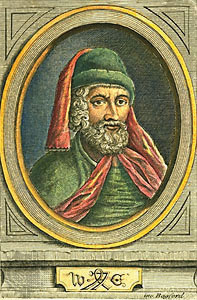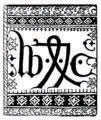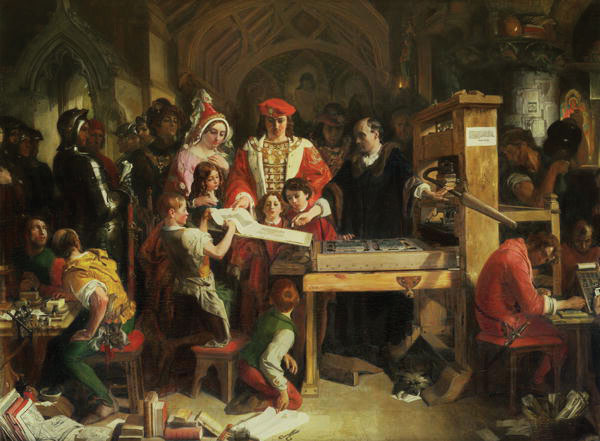2.2: William Caxton y la impresión en Inglaterra
- Page ID
- 104195
- Reconocer los efectos de la imprenta de William Caxton en el desarrollo de la lengua inglesa y la literatura británica.
Con la supresión del idioma inglés antiguo en la época de la conquista normanda y el reemplazo del inglés por el francés en las sedes oficiales, el inglés podría haberse perdido para siempre. En cambio, el idioma inglés sobrevivió y finalmente floreció a finales de la Edad Media. El futuro del idioma inglés se aseguró aún más con la llegada de William Caxton y la imprenta a Inglaterra. Vea una mini conferencia en video sobre Caxton para conocer la influencia de Caxton en el idioma inglés.

Daniel Maclise, 1851
La Imprenta
En 1476, Caxton instaló una imprenta en las inmediaciones de la Abadía de Westminster y comenzó a imprimir libros, algunos en latín como había sido tradicional, pero Caxton también imprimió libros en inglés. Debido a que no había estandarización en la ortografía inglesa, las elecciones de Caxton a menudo se convirtieron en el estándar.

Dispositivo de impresión de Caxton.

Caxton mostrando el primer ejemplar de su impresión al rey Eduardo IV en el Almonry, Westminster.
La Biblioteca Británica ha puesto a disposición en línea una comparación de las dos impresiones de Caxton de los cuentos de Canterbury de Chaucer, 1476 y 1483. Además, Barbara Bordalejo en el Proyecto de Cuentos de Canterbury en la Universidad De Montfort proporciona una versión digitalizada de los manuscritos de la Biblioteca Británica que permite al lector ver el texto en inglés medio lado a lado con la versión manuscrita y buscar líneas y palabras específicas. Archivos Nacionales de Gran Bretaña contiene el primer documento impreso por Caxton.
La estación de radio KUHF en Houston, Texas transmite “Motores de nuestro ingenio”. John H. Lienhard, profesor emérito de Ingeniería Mecánica e Historia de la Universidad de Houston, escribió y narra un audio de un episodio sobre Caxton y la imprenta. El sitio web incluye tanto el podcast como un texto escrito.
Llave para llevar
- El establecimiento de Caxton de la imprenta en Inglaterra ayudó a estandarizar el idioma inglés y promover el uso del inglés en textos escritos.
Ejercicios
- La Biblioteca Folger Shakespeare ofrece una demostración en video de una imprenta moderna temprana. Mientras ve el video, haga una lista de palabras utilizadas en las primeras técnicas de impresión que todavía se utilizan, incluso con las técnicas de impresión computarizada actuales.
- A Caxton se le atribuye haber ayudado a promover el uso del idioma inglés. Después de leer la sección de la Biblioteca Británica sobre Textos de Caxton, incluida la sección sobre el inglés de Caxton, escribir un breve párrafo explicando por qué Caxton optó por imprimir obras en lengua vernácula y no en latín.
Recursos: William Caxton y la impresión en Inglaterra
Biografía
- “Chaucer de Caxton”. Tesoros en su totalidad. Biblioteca Británica. http://www.bl.uk/treasures/caxton/homepage.html
- “La vida de Caxton”. Tesoros en su totalidad: Chaucer de Caxton. Biblioteca Británica. http://www.bl.uk/treasures/caxton/caxtonslife.html
- William Caxton (c.1422—1492). Figuras Históricas. BBC. http://www.bbc.co.uk/history/historic_figures/caxton_william.shtml
- “William Caxton”. Historia. Gente Famosa y la Abadía. Abadía de Westminster. http://www.westminster-abbey.org/our-history/people/william-caxton
Imprenta
- “El inglés de Caxton”. Tesoros en su totalidad: Chaucer de Caxton. Biblioteca Británica. http://www.bl.uk/treasures/caxton/english.html
- “Caxton's Technologies”. Tesoros en su totalidad: Chaucer de Caxton. Biblioteca Británica. http://www.bl.uk/treasures/caxton/caxtonstechnologies.html
- “Textos de Caxton”. Tesoros en su totalidad: Chaucer de Caxton. Biblioteca Británica. http://www.bl.uk/treasures/caxton/caxtonstexts.html
- “La primera página impresa en Inglaterra”. Tesoros. Archivos Nacionales. http://www.nationalarchives.gov.uk/museum/item.asp?item_id=9
- “William Caxton”. John H. Leinhard. Motores de Nuestro Ingenio. Colegio de Ingeniería de la Universidad de Houston. podcast y texto. http://www.uh.edu/engines/epi785.htm
Chaucer de Caxton
- Cuentos de Canterbury de Caxton: Las copias de la biblioteca británica. Bárbara Bordalejo. Proyecto Cuentos de Canterbury. Universidad De Montfort. http://www.cts.dmu.ac.uk/Caxtons/
- “Chaucer de Caxton”. Tesoros en su totalidad. Biblioteca Británica. http://www.bl.uk/treasures/caxton/homepage.html
Video
- “Impresión 101.” Steven Galbraith, Andrew W. Mellon Curador de Libros. Biblioteca Folger Shakespeare. http://youtu.be/lX6e8Q2nc5A
- William Caxton y la Imprenta. Dra. Carol Lowe. Colegio Comunitario McLennan. http://www.youtube.com/user/DrLoweMCC#p/u/18/1lMn5OGJrPU


